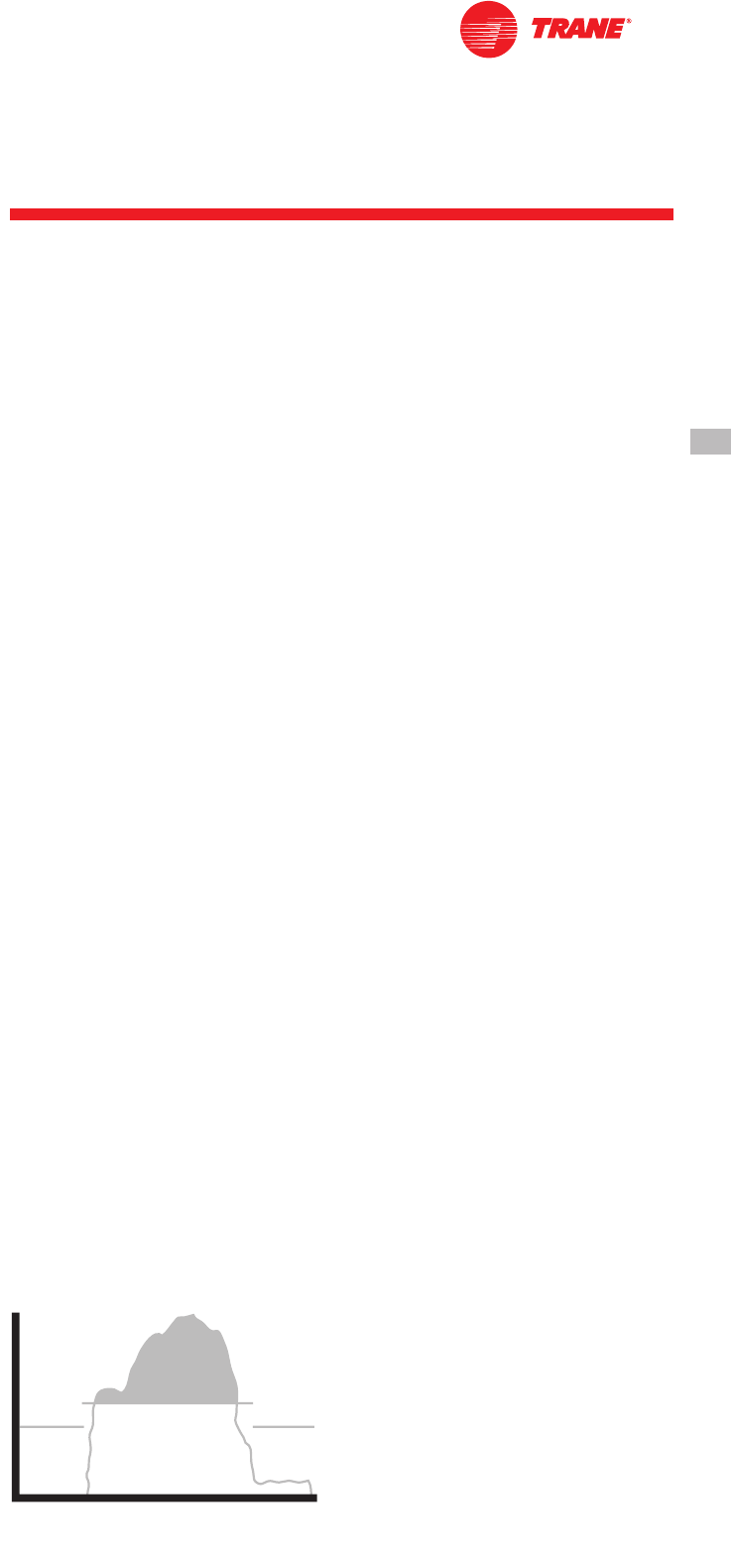
Superior Control with
Tracer
™
Chiller Controls
7
RLC-PRC005-E4
The End of Nuisance
Trip-Outs and
Unnecessary Service Calls?
The Adaptive Control
™
microprocessor
system enhances the air-cooled Series R
chiller by providing the very latest chiller
control technology. With the Adaptive
Control microprocessor, unnecessary
service calls and unhappy tenants are
avoided. The unit does not nuisance-trip
or unnecessarily shut down. Only when
the Tracer chiller controls have
exhausted all possible corrective
actions, and the unit is still violating an
operating limit, will the chiller shut
down. Controls on other equipment
typically shut down the chiller, usually
just when it is needed the most.
For Example:
A typical five-year-old chiller with dirty
coils might trip out on high-pressure
cutout on a 38°C [100°F] day in August.
A hot day is just when comfort cooling
is needed the most. In contrast, the air-
cooled Series R chiller with an Adaptive
Control microprocessor will stage fans
on, modulate the electronic expansion
valve, and modulate the slide valve as it
approaches a high-pressure cutout,
thereby keeping the chiller on line when
you need it the most.
System Options: Ice Storage
Trane air-cooled chillers are well-suited
for ice production. The unique ability to
operate at decreased ambient
temperature while producing ice results
in approximately the same amount of
work for the compressor. An air-cooled
machine typically switches to ice
production at night. Two things happen
under this assumption. First, the leaving
brine temperature from the evaporator
4. Freeze ice storage
5. Freeze ice storage when comfort
cooling is required
6. Off
Tracer optimization software controls
operation of the required equipment
and accessories to easily move from
one mode of operation to another. For
example: even with ice-storage systems,
there are numerous hours when ice is
neither produced nor consumed, but
saved. In this mode, the chiller is the
sole source of cooling. For example, to
cool the building after all ice is produced
but before high electrical-demand
charges take effect, Tracer sets the air-
cooled chiller leaving-fluid set point to
its most efficient setting and starts the
chiller, chiller pump, and load pump.
When electrical demand is high, the ice
pump is started and the chiller is either
demand limited or shut down
completely. Tracer controls have the
intelligence to optimally balance the
contribution of the ice and the chiller in
meeting the cooling load.
The capacity of the chiller plant is
extended by operating the chiller and ice
in tandem. Tracer rations the ice,
augmenting chiller capacity while
reducing cooling costs. When ice is
produced, Tracer will lower the air-
cooled chiller leaving-fluid set point and
start the chiller, ice and chiller pumps,
and other accessories. Any incidental
loads that persists while producing ice
can be addressed by starting the load
pump and drawing spent cooling fluid
from the ice storage tanks.
For specific information on ice storage
applications, contact your local Trane
sales office.
is lowered to around -5.5 to -5°C [22 to
24°F]. Second, the ambient temperature
has typically dropped about 8.3 to 11°C
[15 to 20°F] from the peak daytime
ambient. This effectively places a lift on
the compressors that is similar to
daytime running conditions. The chiller
can operate in lower ambient at night
and successfully produce ice to
supplement the next day’s cooling
demands.
The Model RTAC produces ice by
supplying ice storage tanks with a
constant supply of glycol solution. Air-
cooled chillers selected for these lower
leaving-fluid temperatures are also
selected for efficient production of
chilled fluid at nominal comfort-cooling
conditions. The ability of Trane chillers to
serve “double duty” in ice production
and comfort cooling greatly reduces the
capital cost of ice-storage systems.
When cooling is required, ice-chilled
glycol is pumped from the ice storage
tanks directly to the cooling coils. No
expensive heat exchanger is required.
The glycol loop is a sealed system,
eliminating expensive annual chemical
treatment costs. The air-cooled chiller is
also available for comfort-cooling duty
at nominal cooling conditions and
efficiencies. The modular concept of
glycol ice-storage systems, and the
proven simplicity of Trane Tracer
™
controls, allow the successful blend of
reliability and energy-saving
performance in any ice-storage
application.
The ice-storage system is operated in
six different modes, each optimized for
the utility cost at a particular time of day.
1. Provide comfort cooling with chiller
2. Provide comfort cooling with ice
3. Provide comfort cooling with ice and
chiller
Figure 3 — Ice storage demand cost savings
MN 6 A.M. NOON 6 P.M. MN
ICE
CHILLER
LOAD


















